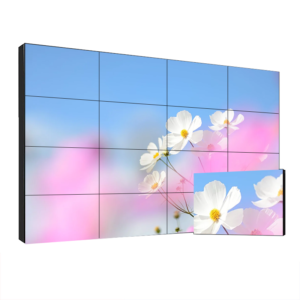Comparative Analysis of LED Screens and Jeryo Splicing Displays: Key Insights for Digital Signage 🌟
As digital signage continues to evolve, two primary display technologies dominate the market: LED screens and Jeryo splicing screens. While both have unique features, understanding their differences is essential for making informed decisions based on specific needs. This article explores the attributes, advantages, and disadvantages of each technology, helping you choose wisely for your digital signage applications.

What is a Jeryo Splicing Screen?
In essence, a Jeryo splicing screen is a sophisticated unit that forms part of an LCD video wall. These screens can function as monitors but excel in scenarios requiring large-scale LCD splicing. Their compact design makes them perfect for areas where space is limited, such as in educational institutions or restaurants where displays are required to stay closely positioned.

The Process of Screen Splicing
Screen splicing involves integrating images from various sources onto a single display. In this technology, images maintain their original format without the need for extensive editing. This contrasts with LED displays, where images often require adjustments for optimal viewing. As such, Jeryo splicing screens can deliver a more authentic representation of the source material, while LED displays may necessitate alterations that can dilute image integrity.
Understanding Seamless Splicing Technology
Seamless splicing technology in digital video production creates the illusion of a continuous image or action by seamlessly combining clips. This technique relies on specialized projection technology and larger screens. Recent advancements have integrated LED technology into this process, allowing each LED pixel to independently emit light. Consequently, the need for traditional seamless splicing films is declining as digital LED screens offer improved consistency and quality.
LED Screens vs. Jeryo Splicing Displays: Pros and Cons
To effectively evaluate which display technology suits your needs, it’s crucial to examine the advantages and disadvantages of both.
Advantages of Jeryo Splicing Screens:
-
High Resolution: Jeryo splicing screens offer superior resolution, with the ability to achieve Full HD and higher, ensuring crystal-clear visuals that can’t be matched by LED screens.
-
Consistent Brightness: Unlike LED screens, which can exhibit varying brightness levels depending on the viewing angle, Jeryo splicing displays maintain uniform brightness across all angles, enhancing viewer experience.
-
Excellent Contrast Ratios: Typically, splicing screens boast high contrast ratios, ranging from 1200:1 to 10000:1, providing enhanced depth to the displayed images.
-
Durability: Jeryo splicing screens can outlast LED screens due to their lower operational strain, thus potentially reducing long-term maintenance costs.
-
Versatility: Their ability to support diverse input formats offers greater adaptability compared to traditional LED screens.
Disadvantages of Jeryo Splicing Screens:
-
Indoor Limitations: Most Jeryo splicing screens are designed for indoor use; their components are less resistant to environmental factors like moisture and dust.
-
Visible Seam Lines: One of the main drawbacks is the visible seams at the junctions of spliced screens, which can detract from the overall aesthetic compared to the seamless nature of LED displays.
Advantages of LED Screens:
-
Seamless Presentation: LED screens do not have visible seams, ensuring a continuous and uninterrupted visual experience.
-
No Air Gaps: The absence of air gaps makes colors appear more vibrant and vivid, enhancing image quality.
-
Adjustable Brightness: LED screens provide flexibility with brightness settings, making them suitable for varied lighting conditions.
-
Wide Color Gamut: LEDs can render a broad spectrum of colors, surpassing the limited palette available on splicing screens.
-
Weather Resistance: LED screens are built to withstand environmental conditions, making them ideal for outdoor use.
-
Reduced Distortion: LED displays maintain clarity, avoiding issues with ghosting or distortion that can occur with other technologies.
Disadvantages of LED Screens:
-
Lower Resolution: Generally, LED screens have lower resolution capabilities compared to Jeryo splicing screens, which may limit image sharpness.
-
Contrast Limitations: The contrast ratios on LED screens tend to be lower, which could affect image clarity in certain applications.
-
Higher Costs: The price point for LED screens is typically higher, not only in initial investment but also in maintenance and repair.
-
Heat Generation: LED technology can generate heat, necessitating additional cooling solutions that are less of a concern with splicing screens.
Choosing the Right Display Technology
Selecting between Jeryo splicing screens and LED displays requires consideration of several critical factors:
- Installation Environment: For outdoor use or areas exposed to moisture, LED screens are the preferred choice due to their waterproof features.
- Cost Efficiency: Jeryo splicing screens tend to be more economical upfront, and potential maintenance savings can add up over time.
- Content Quality Requirements: If your application necessitates high-definition clarity, Jeryo splicing displays are advantageous, while LED screens provide a more cost-effective alternative for general viewing purposes.
- Brightness Requirements: Evaluate the necessary brightness levels for your application, as splicing screens can provide consistent visuals without the risk of excessive brightness issues.
Conclusion
In summary, understanding the distinctions between Jeryo splicing screens and LED displays can significantly influence your digital signage choices. While Jeryo splicing screens offer high resolution and durability, LED screens provide outdoor versatility and vibrant color rendering. By evaluating your specific needs—considering factors like environment, cost, and content type—you can make a well-informed decision on the display technology that will best serve your advertising or informational objectives.




